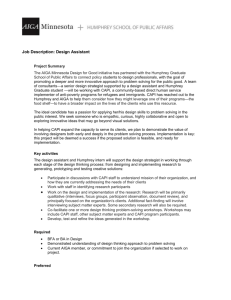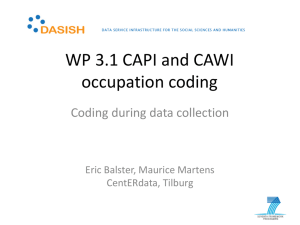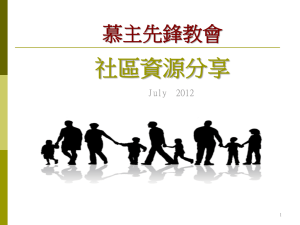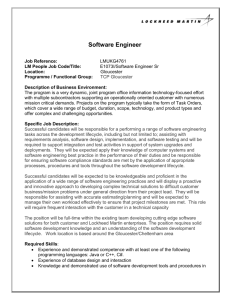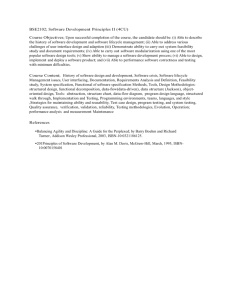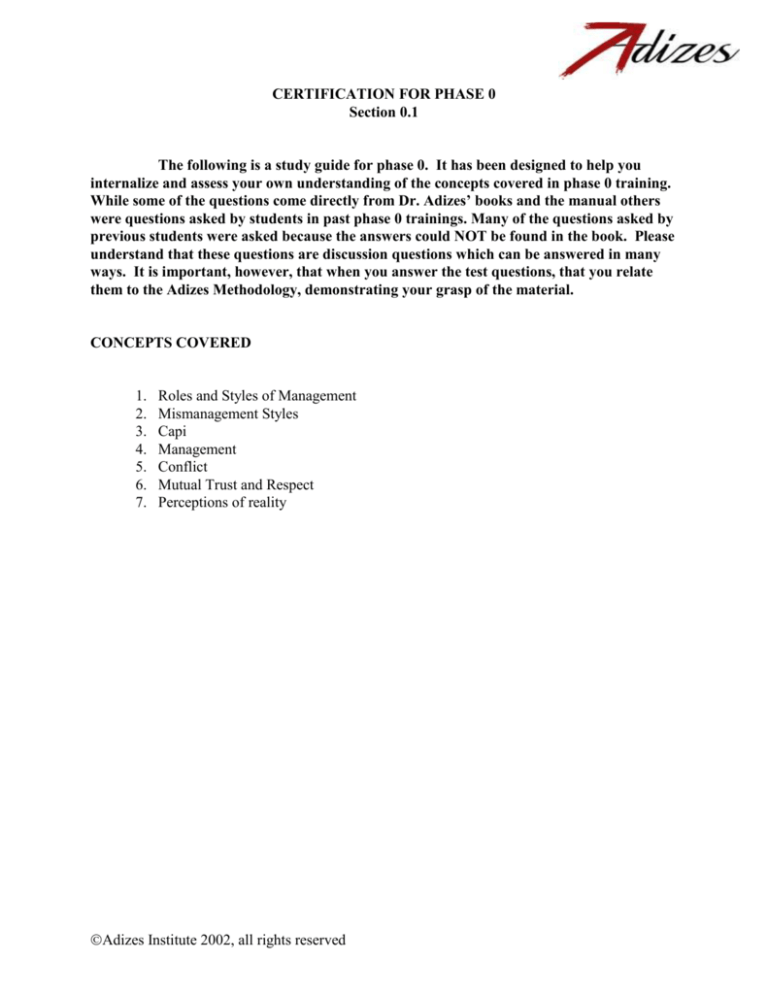
CERTIFICATION FOR PHASE 0
Section 0.1
The following is a study guide for phase 0. It has been designed to help you
internalize and assess your own understanding of the concepts covered in phase 0 training.
While some of the questions come directly from Dr. Adizes’ books and the manual others
were questions asked by students in past phase 0 trainings. Many of the questions asked by
previous students were asked because the answers could NOT be found in the book. Please
understand that these questions are discussion questions which can be answered in many
ways. It is important, however, that when you answer the test questions, that you relate
them to the Adizes Methodology, demonstrating your grasp of the material.
CONCEPTS COVERED
1.
2.
3.
4.
5.
6.
7.
Roles and Styles of Management
Mismanagement Styles
Capi
Management
Conflict
Mutual Trust and Respect
Perceptions of reality
Adizes Institute 2002, all rights reserved
SAMPLE QUESTIONS
PHASE 0 - CONCEPTUAL FOUNDATIONS
Section 0.1
I. Roles and Styles of Management
1)
2)
3)
4)
5)
6)
7)
8)
9)
10)
11)
12)
13)
14)
15)
16)
17)
Describe the different roles of management.
Describe the different styles of management.
Describe the conflict created between the different roles of management.
Describe the conflict created between the different styles of management.
Is anyone ever a PAEI?
How can you predict the quality of decisions?
What are the differences and similarities between (A) and (I)?
Describe back up behavior.
Is it necessary for members of a team to have the same values? Same culture? Same style?
What is the P function of a hospital?
What is the "P" function of the Adizes Institute?
Does one's style (PAEI) stay the same forever? Can one change? How?
As a consultant, how would you help someone develop more (P), (A), (E) or (I)?
Which role is the easiest to develop?
In the PAEI, are some more attracted to each other than others (complementary), are some more re active to
each other?
What is the difference between a mechanical organization and an organic organization?
If an organization does not have enough A, how will it make up for that lack of A?
II. Mismanagement Styles
18)
19)
20)
21)
22)
23)
24)
25)
26)
27)
Describe the five mismanagemt styles.
Describe is the miscommunication between the different mismanagement styles?
What are the personality needs for a (P000), an (0A00), an (00E0), (000I) and an (0000)?
Is oooI an Integrator?
To what style of management does the following expression apply: "he can't see the forest from the trees"?
Describe the different approaches you would use when you communicate with a (P000), an (0A00), an
(00E0), (000I) and an (0000)?
Describe the weaknesses of each mismanagement style.
What are the causes of deadwood?
What are the characteristics of deadwood?
How does a Paei become Pooo?
III. Capi and Authorance
28)
29)
30)
31)
32)
33)
34)
35)
36)
37)
What is Capi?
What is Authorance?
Define Authority, Power and Influence as used in the Adizes Methodology?
How can you predict the implementation of decisions?
What skills/roles can you develop to increase your influence?
Why should your capi = your task?
Describe the relationship between capi and PAEI.
Why is it desirable that responsibility is not and should not be equal to authority?
What is "authorance"? How is it different from "capi"? How is it different from control? Can you have
authorance without capi? Can you have capi without authorance?
What are the difficulties of finding capi in a democratic organization?
Adizes Institute 2002, all rights reserved
38)
39)
40)
41)
42)
43)
44)
45)
46)
How are capi and mutual trust related?
"Speak softly and carry a big stick." What is this in authorance?
If someone speaks nicely, and persuasively, does he have influence?
Is capi for individuals growing or declining in modern society?
What are the differences in interest in coalescing capi?
Power corrupts, absolute power corrupts absolutely. Discuss in Adizes terms.
What factors determine how much power an individual has? Give examples.
Does an increase in authorized power increase influence?
Where would you find more capi-navy or air force?
IV. Management
47)
48)
49)
What is the difference between the textbook PAEI manager and the Adizes manager as a team member?
What are the nine characteristics of a good manager? Does this type of a manager ever exist?
What should be the optimal Adizegram for a good manager?
V.
Conflict
50)
51)
52)
53)
What are the causes of conflict?
Discuss the dimensions of the different causes of conflict.
When there is conflict, how do you dissect it to clear it?
What is necessary in order for conflict to be constructive? Why?
VI.
Mutual Trust and Respect
54)
55)
56)
57)
58)
Define mutual respect. How would you know if there is or is not mutual respect?
Is lack of MT & R the cause or manifestation of conflict?
What is the difference between mutual trust and mutual respect?
Are mutual trust and mutual respect inputs or outputs in Adizes? Why?
What are the inputs that create mutual respect and mutual trust? And how do those inputs create mutual trust
and mutual respect?
Good people are the ones that command and grant mutual trust and respect. Discuss.
Can I respect someone I don't trust? Can I trust someone I don't respect?
What does "love,” mean in an organization whether business or non-profit?
59)
60)
61)
VII. Perception of Reality
62)
63)
64)
65)
66)
67)
68)
What should the sequence of perceptions in planning be?
What should the sequence of perceptions in control be?
Where do perceptions (is, want, should) fit in the Adizes conceptual map?
If P= is, and E = want, and A= should, then what is I?
What is an example of an "is want should" confusion?
How would you account for phenomena that is not either "is", "want" or "should", i.e. totally outside of these
circles of perception?
Is there a relationship between authorance and perceptions? In other words, how do the is, want & should
perceptions relate to authority, power and influence?
SECTION TWO
CONCEPTS COVERED
1. Life Cycles of Organizations - Growth Phases
Adizes Institute 2002, all rights reserved
2.
3.
4.
5.
6.
7.
Life Cycles of Organizations - Aging Phases
Analysis of Life Cycles
Problem Solving and Decision Making
Structures of Organizations
The Adizes Program for Treating Organizations
Mixed Bag
Adizes Institute 2002, all rights reserved
SAMPLE QUESTIONS
PHASE 0 - CONCEPTUAL FOUNDATIONS
Section 0.2
I. Lifecycle of Organizations – Growth Phases
1) Describe the growing phases in the lifecycle.
2)
What is the difference in "E" before and after Adolescence? Why is it unstable during Adolescence?
3)
How do you institutionalize E in adolescence? In prime?
4)
Describe the characteristics of an Adolescent company. How does it behave? Typical problems?
5)
Compare and contrast Go Go and Prime in the lifecycle?
6)
How do you know that a company is in Prime?
7)
In which stage of the lifecycle of an organization is there a need for a change in leadership from Entrepreneur
to professional management and why?
II. Lifecycle of Organizations – Aging Phases
8)
9)
10)
11)
12)
13)
Describe the aging phases in the lifecycle.
What is the difference between Aristocracy in premature aging and Aristocracy after Prime?
What causes aging?
Where does (E) become negative (disappear) in the life cycle?
Are all the problems in aging pathological?
Can the public sector give birth to aristocratic or bureaucratic organizations from the start?
III. Analysis of Lifecycles
14)
15)
16)
17)
18)
19)
20)
21)
22)
23)
24)
25)
Describe "E" behavior in the life cycle of an organization?
What are the markers that determine the passage from one lifecycle stage to the next?
Describe the nature of Capi at each stage of the life cycle.
What is the difference in organizational climate between the growing and aging stages in the life cycle?
Are artistic organizations in continuous Go Go? What are the difficulties in reaching Prime?
What are the normal and abnormal problems of each stage of the organizational lifecycle?
Is there a full balance of form vs. functionality at any stage? Why?
How do you place an organization on the lifecycle if different parts of the organization are on different parts
of the lifecycle?
Do all companies really have to hit each stage of the lifecycles? Specifically do all companies pass through
the GoGo stage with crises? Cannot companies move from infancy to adolescence and develop A at the same
time?
What are the similarities and differences between the human lifecycle and the corporate lifecycle?
Describe and explain the required leadership style along the different lifecycle stages.
If we "should" have more (I) earlier in the lifecycle, how can you foster it when a) you have both limited time
and resources and b) you do not want I to divert the importance of the P and E?
IV. Problem Solving & Decision Making
26)
27)
28)
29)
30)
31)
Team Capi provides for efficiency. But the process of coalescing is inefficient. Comment.
What are the four imperatives of decision-making? Why are they important to have? Are they sequential?
What is a problem?
What is a pre problem?
What is the technology for solving a pre problem?
A union representative goes to unionize a nonunion factory. What type of problem does she have? How
should she go about solving that problem?
Adizes Institute 2002, all rights reserved
32)
33)
34)
35)
36)
37)
38)
39)
40)
41)
What are the 8 steps in decision-making?
At which step of the 8 steps are you at the lowest in behavioral response and why?
Why do we need the 8 step decision-making process?
Describe the behavior of each mismanagement style over the 8 step decision-making process.
In a complementary team, once a decision is made who is really responsible?
In the eight steps, who makes, who takes and who accepts a decision?
What is the driving force in creating a complementary team Capi or PAEI?
Although it makes sense that we need a complementary team, nevertheless, doesn't someone need to be the
"boss"?
How does training to handle more pain increase mutual respect?
What is meant by a learning environment?
V. Structure of Organizations
42)
43)
44)
45)
46)
What do the Sales, Production, and Personnel departments have in common and how?
How should the Sales, Production, and Personnel departments be organized in regard to other departments?
Which departments should not be together, (under one hat) in an organization?
What is the difference between delegation and decentralization in terms of capi and PAEI?
What are the PAEI codes for Personnel, Human Resource Development, Sales, Marketing, Production, R+D,
finance, accounting and legal departments of an organization and how should they be structured?
VI. The Adizes Program for treating organizations
47)
48)
49)
50)
51)
52)
53)
54)
55)
56)
57)
58)
59)
VII.
60)
61)
62)
63)
64)
How do you maintain the E in an organization, especially when the organization has to be run as a
dictatorship in order to implement decisions?
What are the methods to promote PAEI within individuals when certain types of contributions are needed?
What is the sequence of therapy for Adolescence? Describe the sequence & why.
Which departments do you need to build when getting out of the Founders Trap, and in what sequence?
Describe the therapy used for an organization in Prime.
What is the therapy for premature aging?
What is the correct therapy in transition from Go Go to Adolescence?
When should you decentralize an organization?
What are the different phases in the Adizes Methodology for organizational change?
Explain the following: “The Adizes Methodology is a holistic approach to organizational change.”
What does decentralization do to the ratio of A, E, and P in an organization?
Can it happen that the party with capi refuses to take action? How is that managed?
How do you change a company?
Mixed Bag
What are the most important concepts to teach in Phase 0?
How does the perceived relative market share affect the Entrepreneurial spirit of an organization?
How can you predict organizational success?
Explain the Adizes conceptual map.
Is the answer to the following question the right answer? “How can you predict if there is a good decision?
1) If there is a complimentary team
2) If there was mutual respect
Adizes Institute 2002, all rights reserved

